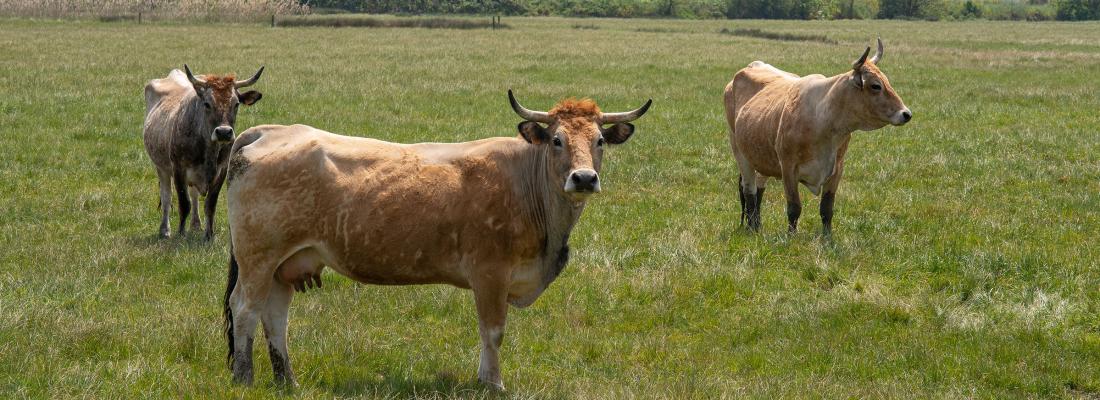Agroecology Reading time 2 min
Biodiversity-friendly livestock farms: a source of inspiration for the future
Published on 09 January 2024

The issue of biodiversity loss is a large-scale challenge across the globe. This challenge is even more difficult to overcome due to practices such as deforestation and increasingly intensive farming, which leads to an excessive use of chemical inputs such as pesticides and fertilisers as well as to a worrying standardisation of agricultural landscapes. Biodiversity could be preserved, especially in Europe, by extensive livestock farms, which have low animal density and use fewer inputs than more intensive livestock farms. However, while a wide range of biodiversity-friendly extensive livestock systems do exist, there is little to no information about their productivity and environmental impacts, besides those on biodiversity.
With that in mind, INRAE researchers launched an exploratory study to better understand and quantify the environmental impacts of biodiversity-friendly livestock farms. The study was based on a small sample of very diverse farms, some of which were very innovative. The sample contained seven farms with herbivores, particularly cows, in France and England, positioned on gradients of intensification and commitment to biodiversity. The sample included one agriculture rewilding farm and three suckler beef farms (two of which were considered biodiversity-friendly) plus three dairy farms (one of which used biodiversity-friendly practices). The approach used included life cycle assessment1 of six environmental impacts (i.e. climate change, terrestrial acidification, freshwater eutrophication², marine eutrophication, land occupation and energy demand) and each farm's energy efficiency and production levels.
The results revealed that while the four extensive and biodiversity-friendly livestock farms had lower production levels, they also had lower environmental impacts and higher energy efficiency than the three more intensive farms.
In the sample, one farm in England focussed on restoring biodiversity via agricultural rewilding, which rebuilds a natural ecosystem by promoting spontaneous ecological processes. This farm first halted all agriculture and let vegetation grow naturally. It then gradually introduced traditional breeds of cattle, ponies and pigs, along with red, roe and fallow deer, to create an almost natural ecosystem, in which the sole human interaction is that animals are occasionally harvested. This farm had very low greenhouse gas emissions, and carbon storage in the soil and plants that was 8 times as large as these emissions, but its production level was also extremely low. A suckler beef farm in the French Paysans de nature network had climate-impact and meat-production levels that were half those of a traditional organic suckler beef farm in the sample.
The study's conclusions highlighted some important trade-offs in reconciling biodiversity restoration, reduction of the environmental impacts of livestock farming, and food production. Development of biodiversity-friendly extensive livestock farms must form part of a vision to reduce the size of ruminant herds and consumption of animal products. This can be supported by incentives set out in the European Union's Green Deal to, for example, restore permanent grasslands, reduce pesticide use and promote organic agriculture.
Overall, these results illustrate the potential, or indeed necessity, of harmonious coexistence between livestock farming and biodiversity to ensure a sustainable future. These conclusions, based on a small sample, call for more studies on such systems outside the prevailing economic model in order to redesign current agricultural practices and promote more environmentally friendly approaches to protect biodiversity.
INTENSIVE VERSUS EXTENSIVE MODELS
The main difference between extensive and intensive farms is in how the land is used, the density of the animals present, rates of synthetic input use, productivity (quantity of products per animal or per hectare) and environmental impacts. Both models have advantages and disadvantages, and their positions on the gradient depend on a wide range of factors, such as production goals, available resources and environmental concerns.
1 Aggregating impacts on the farm and those related to the inputs (buildings, diesel, fertilisers, pesticides, animal feed) used on the farm.
2 Eutrophication: Input of excess nutrients into water, leading to overgrowth of vegetation, a decrease in oxygen levels and an imbalance in the ecosystem.
REFErence
Mondière A., Corson M.S., Auberger J. et al. (2024). Trade-offs between higher productivity and lower environmental impacts for biodiversity-friendly and conventional cattle-oriented systems. Agricultural Systems 213 : 103798. https://doi.org/10.1016/j.agsy.2023.103798
Work resulting from a thesis funded by ADEME, the Brittany Region and the Olga Triballat Institute.
